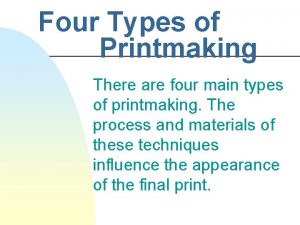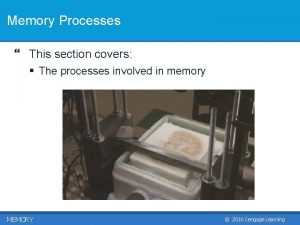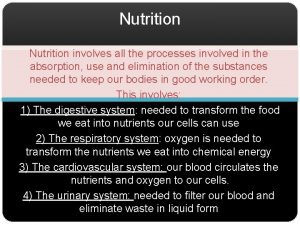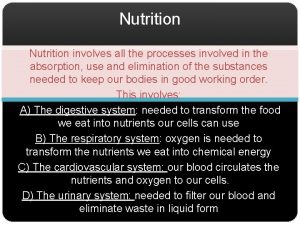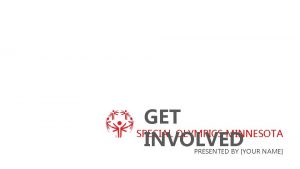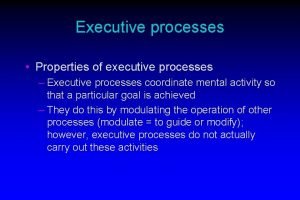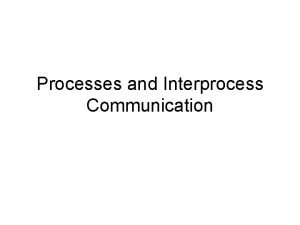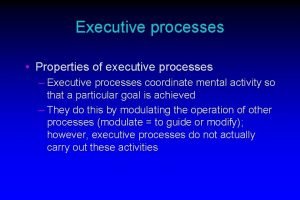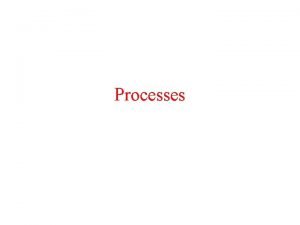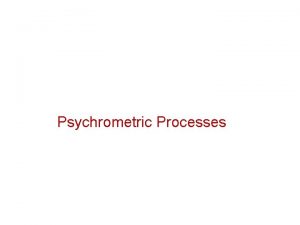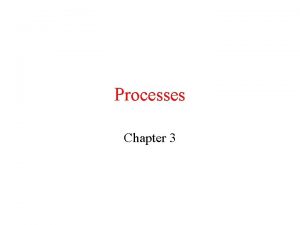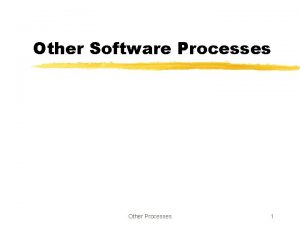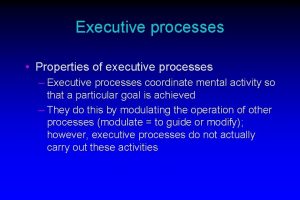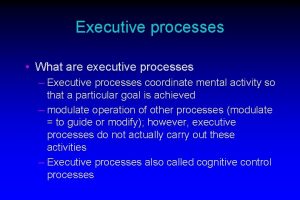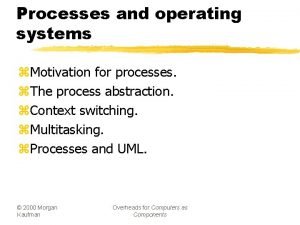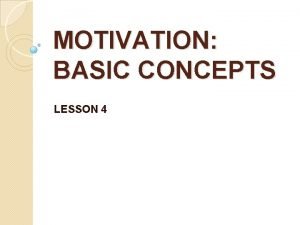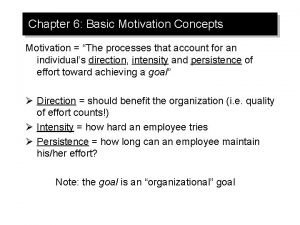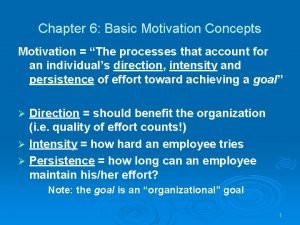Motivation Motivation Motivation All the processes involved in




































- Slides: 36

Motivation

Motivation �Motivation – All the processes involved in starting, directing, and maintaining physical and psychological activities.

Types of Motivation �Drive – Biologically instigated motivation. �Hunger �Thirst �Reproduction

Types of Motivation �Motive – An internal mechanism that selects and directs behavior. The term motive is often used in the narrower sense of a motivational process that is learned, rather than biologically based (as are drives).

Types of Motivation �Intrinsic Motivation – The desire to engage in an activity for its own sake, rather than for some external consequence, such as a reward.

Types of Motivation �Extrinsic Motivation – The desire to engage in an activity to achieve an external consequence, such as a reward.

Types of Motivation �Conscious Motivation – Having the desire to engage in an activity and being aware of the desire.

Types of Motivation �Unconscious motivation – Having a desire to engage in an activity but being consciously unaware of the desire. �Remember Freud’s psychoanalytic theory emphasized unconscious motivation.

Theories of Motivation �Instinct Theory – The now-outmoded view that certain behaviors are completely determined by innate factors. �Flawed because it overlooked the effects of learning and because it employed instincts merely as labels, rather than as explanations for behavior.

Theories of Motivation �Fixed-action Patterns – Genetically based behaviors, seen across a species, that can be set off by a specific stimulus. �The concept of fixed – action patters has replaced the older notion of instinct.

Theories of Motivation �Drive Theory �Need – In drive theory, a need is a biological imbalance (such as dehydration) that threatens survival if the need is left unmet. � Biological needs are believed to produce drives. � Homeostasis – The body’s tendency to maintain a biologically balanced condition, especially with regard to nutrients, water, and temperature.

Theories of Motivation �Cognitive Theory – Motivation is a result of learning and thinking �Locus of Control – An individual’s sense of where his or her life influences originate – internally or externally.

Theories of Motivation �Maslow’s Humanistic Theory – Said humans act on their most pressing needs, which are organized in a natural hierarchy. �Hierarchy of Needs – The notion that needs occur in priority order, with biological needs as the most basic.

Abraham Maslow’s Hierarchy of Needs

Achievement Motivation �Need for Achievement – A mental state that produces a psychological motive to excel or to reach some goal.

Cross – Cultural Perspective on achievement �Individualism – The view, common in the Euro. American world, that places a high value on individual achievement and distinction. �Collectivism – The view, common in Asia, Africa, Latin America, and the Middle East, that values group loyalty and pride over individual distinction.

Hunger & Thirst Motivation �Set Point - Refers to the tendency of the body to maintain a certain level of body fat and body weight. �Volumetric Thirst – A drop in extracellular fluid levels (fluid outside the cells in your body, as in the blood). �Osmotic Thirst – A drop in intracellular fluid levels (fluids that move through the cell walls of your body and escaped in the form of sweat, urine, feces, mucus, and moisture. )

Sexual Motivation �Sexual Response Cycle – The four-stage sequence of arousal, plateau, orgasm, and resolution occurring in both men and women. �Sexual Cues �Sexual Scripts – Socially learned ways of responding in sexual situations.

Motives in Conflict �Approach-Approach Conflict – A conflict in which one must choose between two equally attractive options.

Motives in Conflict �Approach-Avoidance Conflict – A conflict in which there are both appealing and negative aspects to the decision to be made.

Motives in Conflict �Avoidance-Avoidance Conflict – A conflict in which one has to choose between two equally unattractive options.

Motives in Conflict �Multiple Approach-Avoidance Conflict – A conflict in which one must choose between options that have both many attractive and many negative aspects.

How and Why do we Experience Stress? �Stress – A physical and mental response to a challenging or threatening situation. �Stressor – A stressful stimulus, a condition demanding adaptation.

Traumatic Stressors �Traumatic Stressors – A situation that threatens ones physical safety, arousing feelings of fear, horror, or helplessness. �Catastrophes �Posttraumatic Stress Disorder – Delayed stress reaction in which an individual involuntarily reexperiences emotional, cognitive, and behavioral aspects of past trauma.

Physical Stress Response �Initial Arousal �Protective behavioral reaction, usually in the form of fight or flight. �Internal responses of the autonomic nervous system and endocrine system. �A decrease in the effectiveness of the immune system.

Arousal �Acute Stress – A temporary pattern of stressoractivated arousal with a distinct onset and limited duration. �Example – House is on Fire �Chronic Stress – Continuous stressful arousal persisting over time. �Example – Financial or relationship problems.

Fight or Flight �Fight or Flight Response – Sequence of internal processes preparing an organism for struggle or escape.

The General Adaptation Syndrome �General Adaptation Syndrome – Pattern of general physical responses that take essentially the same form in responding to any serious chronic stressor. �Three Stages � Alarm Reaction � Stage of Resistance � Stage of Exhaustion

The General Adaptation Syndrome �Alarm Reaction �First stage of the GAS, during which the body mobilizes its resources to cope with a stressor.

The General Adaptation Syndrome �Stage of Resistance �Second stage of the GAS, during which the body adapts to and uses resources to cope with a stressor.

The General Adaptation Syndrome �Stage of Exhaustion �Third stage of the GAS, during which the body depletes its resources in responding to an ongoing stressor.

The General Adaptation Syndrome �Tend-and-befriend Model – Stress response model proposing that females are biologically predisposed to respond to threat by nurturing and protecting offspring and seeking social support.

Stress and the Immune System �Psychoneuroimmunology – Multidisciplinary field that studies the influence of mental states on the immune system. �Cytokines – Hormonelike chemicals facilitating communication between brain and immune system.

Type A vs. Type B �Type A – Behavior patterns characterized by intense, angry, competitive, or perfectionistic responses to challenging situations. �Type B – Behavior patterns characterized by relaxed, unstressed approaches to life.

Learned Helplessness �Learned Helplessness – Pattern of failure to respond to noxious stimuli after an organism learns its responses are ineffective.

 Four major process of printmaking
Four major process of printmaking Concurrent in os
Concurrent in os Merchandising conglomerates
Merchandising conglomerates Draw three noncollinear points j k and l
Draw three noncollinear points j k and l Life processes movement
Life processes movement Hình ảnh bộ gõ cơ thể búng tay
Hình ảnh bộ gõ cơ thể búng tay Bổ thể
Bổ thể Tỉ lệ cơ thể trẻ em
Tỉ lệ cơ thể trẻ em Voi kéo gỗ như thế nào
Voi kéo gỗ như thế nào Tư thế worm breton
Tư thế worm breton Chúa yêu trần thế
Chúa yêu trần thế Môn thể thao bắt đầu bằng chữ f
Môn thể thao bắt đầu bằng chữ f Thế nào là hệ số cao nhất
Thế nào là hệ số cao nhất Các châu lục và đại dương trên thế giới
Các châu lục và đại dương trên thế giới Công của trọng lực
Công của trọng lực Trời xanh đây là của chúng ta thể thơ
Trời xanh đây là của chúng ta thể thơ Mật thư tọa độ 5x5
Mật thư tọa độ 5x5 101012 bằng
101012 bằng độ dài liên kết
độ dài liên kết Các châu lục và đại dương trên thế giới
Các châu lục và đại dương trên thế giới Thơ thất ngôn tứ tuyệt đường luật
Thơ thất ngôn tứ tuyệt đường luật Quá trình desamine hóa có thể tạo ra
Quá trình desamine hóa có thể tạo ra Một số thể thơ truyền thống
Một số thể thơ truyền thống Bàn tay mà dây bẩn
Bàn tay mà dây bẩn Vẽ hình chiếu vuông góc của vật thể sau
Vẽ hình chiếu vuông góc của vật thể sau Nguyên nhân của sự mỏi cơ sinh 8
Nguyên nhân của sự mỏi cơ sinh 8 đặc điểm cơ thể của người tối cổ
đặc điểm cơ thể của người tối cổ Ví dụ giọng cùng tên
Ví dụ giọng cùng tên Vẽ hình chiếu đứng bằng cạnh của vật thể
Vẽ hình chiếu đứng bằng cạnh của vật thể Vẽ hình chiếu vuông góc của vật thể sau
Vẽ hình chiếu vuông góc của vật thể sau Thẻ vin
Thẻ vin đại từ thay thế
đại từ thay thế điện thế nghỉ
điện thế nghỉ Tư thế ngồi viết
Tư thế ngồi viết Diễn thế sinh thái là
Diễn thế sinh thái là Dạng đột biến một nhiễm là
Dạng đột biến một nhiễm là
